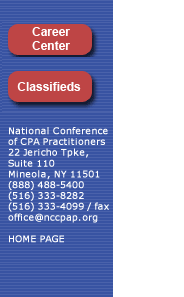

| |
|
|
|
|
|
|
|
|
|
|
|
|
|

October 2004
MEMBERS’
CORNER
BY STANLEY TEPPER, CPA, MBA
Custodial Accounts – on the minor’s death, the account is includible in the minor’s estate. If the parent is the custodian, and dies during the child’s minority, the account is included in the parent’s estate.
Self-Publication Doctrine – The following article is a continuation from the last month’s column on the subject of firing employees and is taken from a recent newsletter of Franklin & Gringer, P.C., Garden City, (516) 228-3131.
In Cweklinsky v. Mobil Chemical Co., the Connecticut Supreme Court was also faced with an issue of publication in a defamation case. But here the question was whether the state recognized the self-publication doctrine. That means that the alleged defamatory statement was communicated only to the employee. Under this doctrine, some states find that publication occurs when a statement is made to an employee regarding discharge reasons because the employee is compelled to repeat the explanation to prospective employers when asked. The court concluded that Connecticut doesn’t recognize the self-publication doctrine.
As in Gray, the alleged defamatory statement arose when the company interpreted the employee to have provided false documentation to excuse an absence and fired the employee for taking paid medical leave without a medical basis. During the trial, the employee testified that he had published the defamatory statements to prospective employers because he felt “compelled” to do so when they asked to why he had been let go.
First, the court noted that in general, no action for defamation exists if an employer publishes defamatory statements only to the employee and the employee later communicates these statements to a third person. But the court found that several other states had carved out an exception to that rule when a defamed former employee communicates the firing reason to prospective employers when the person is asked why he or she left his or her former employment. These courts reasoned that it was fair to hold an employer liable for compelled self-publication because it was reasonably foreseeable that an employee, in seeking new employment, would inevitably be asked why he or she left his or her former employment. The Connecticut court refused to join these other states because acceptance of the self-publication doctrine would have a chilling effect on workplace communication. This would have an adverse effect on the employees who might not receive constructive criticism that would benefit them in the future as well as to prospective employers who might not receive information on applicants from former employers for fear of liability.
What is a wise policy?
Fearing liability, many employers already refuse to divulge any information other than former employees’ names, ranks, and dates of employ to prospective employers seeking references on applicants. This may be a wise policy in light of today’s litigious culture.
Subchapter S Corporations – In doing research in Tax Management, Inc., a subsidiary of The Bureau of National Affairs one of our members observed an interesting aspect to the filing of consolidated income tax returns.
Section 1504(b)(8) was added by §1308 of the Small Business Job Protection Act of 1996, specifically excluding S corporations from includible corporation status for taxable years beginning after 1996, thus precluding an S corporation parent from filing a consolidated return with its C corporation subsidiaries. However, in certain dircumstances, the practical equivalent of a consolidated return may be achieved between an S parent and its wholly owned C subsidiaries. Section 1361(b)(3) permits an S parent to elect to integrate the activity of a wholly owned C subsidiary with itself, thus effecting a practical consolidation. The election procedure (“QSSS election”) is described in Prop. Regs. §1.1361-3; the effect of the election, which is to treat the C corporation subsidiary as a division of its S corporation parent, is described in Prop. Regs. §1.1361-4. For taxable years beginning before 1997, S corporations were effectively barred from filing consolidated returns by virtue of the former S corporation definition which prevented an S corporation from owning 80% or more of the stock of another corporation.(See former §1361(b)(2)(A))
The Weekly Estate Tax newsletter from the law firm of Certilman Balin Adler & Hyman, LLP of East Meadow, (516) 296-7000 furnished the next two articles.
Tax Court Uses Post-death Sale as Check Against Valuation.
Estate Talk
At the time of his death in June 1996, Michel Dunia owned, through a trust, an undeveloped 92.91-acre parcel of land in Victorville, CA, near Los Angeles. The property had been listed for sale for a price of $20 million, but his estate reported a value of $4.05 million. The IRS determined a value of $16.3 million for the property and issued a notice of deficiency, nearly four years later, in the amount of $8.68 million.
Nine months after Michel died, the trustees of his trust executed an agreement to sell the property for $8.4 million. The agreement could be cancelled at any time by the buyer, and that is what happened ten months later. Then after two more years, a 15.87 acre portion of the property was sold for $4.1 million.
Before the tax court, the estate arrived at a value of $4.45 million for the property, and the IRS, $8.5 million, both parties presenting experts who valued the property using comparable sales. However, the government’s expert also relied on the failed $8.4 million agreement and the partial sale for $4.1 million, both of which occurred after the valuation date.
The Tax Court refused to consider the failed agreement because it was not completed and the buyer was never committed to the transaction. The Court did, however, consider the partial sale, but not as a primary indication of the entire property’s date-of-death value.
Instead the Court gave the sale “limited weight,” using it instead as a check against the value determined using comparable sales, and arrived at a value of $5.46 million.
In considering the partial sale, the Court took into account the facts that the sale took place three years after the valuation date, that property values had increased in that three years, that significant improvements had been made to the property, and that the portion sold was the most marketable tract in the property.
Estate of Dunia v. Commissioner
(T.C. Memo. 2004-123, 5-20-04)Crummey Powers –
It is possible to fund a generation-skipping trust with life insurance, but anyone who intends to do so should be aware of a critical pitfall. Generally, life insurance trusts grant the beneficiaries Crummey powers to allow transfers to the trust to qualify for the gift tax annual exclusion. A Crummey power is a temporary right granted to a trust beneficiary to withdraw property gifted to the trust. The beneficiary must be notified of the gift and the Crummey power, which lapses after a certain period. Without this power, the gift of life insurance would not be a gift of a present interest to the trust beneficiaries, and would therefore not qualify for the annual exclusion.
The problem is that the lapse of a Crummey right could be considered a taxable release of a general power of appointment. In other words, unless the power is structured correctly, the beneficiary might make a taxable gift by allowing the power to lapse. This would cause a portion of the trust to be included in the beneficiary’s estate. A generation skipping insurance trust, in order to be effective, must be drafted to avoid this situation.
Section 2041(e) provides a safe harbor of $5,000 or 5% of the trust principal (the “five-and-five” safe harbor). So, limiting the gift to $5,000 per year will generally allow the Crummey power to lapse without a taxable release by the beneficiary. But if the grantor intends to take full advantage of gift tax annual exclusions ($11,000 per year per recipient) for transfers to the trust, he or she could use a “hanging power.”
The “hanging power” technique uses the entire $11,000 exclusion, granting the beneficiary the temporary right to withdraw that amount. But when that power lapses, only the amount that can be covered by the five-and-five safe harbor is allowed to lapse. The power to withdraw the remaining amount “hangs” until the next year, and does not lapse until the five-and-five safe harbor is no longer used to cover other lapsing powers.
